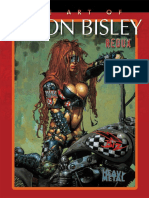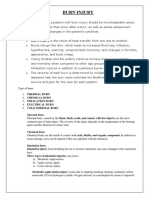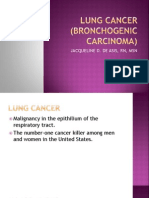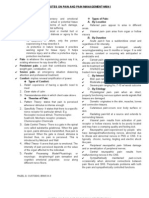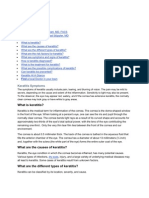100%(1)100% found this document useful (1 vote)
Pain
Pain
Uploaded by
MabesPain is a complex, subjective experience that can be acute, chronic, or intermittent. It serves as a warning signal but is influenced by both physical and psychological factors. The gate control theory proposes that stimulating large diameter nerve fibers can close the "gate" in the spinal cord and inhibit the transmission of pain signals to the brain. A comprehensive pain assessment considers location, intensity, character, duration and impact on function. Management may include both pharmacological and non-pharmacological approaches like heat/cold therapy, massage, transcutaneous electrical nerve stimulation, cognitive techniques like distraction, deep breathing and guided imagery.
Copyright:
© All Rights Reserved
Available Formats
Download as DOCX, PDF, TXT or read online from Scribd
Download as docx, pdf, or txt
Pain
Pain
Uploaded by
Mabes100%(1)100% found this document useful (1 vote)
Pain is a complex, subjective experience that can be acute, chronic, or intermittent. It serves as a warning signal but is influenced by both physical and psychological factors. The gate control theory proposes that stimulating large diameter nerve fibers can close the "gate" in the spinal cord and inhibit the transmission of pain signals to the brain. A comprehensive pain assessment considers location, intensity, character, duration and impact on function. Management may include both pharmacological and non-pharmacological approaches like heat/cold therapy, massage, transcutaneous electrical nerve stimulation, cognitive techniques like distraction, deep breathing and guided imagery.
Copyright
© © All Rights Reserved
Available Formats
DOCX, PDF, TXT or read online from Scribd
Share this document
Did you find this document useful?
Is this content inappropriate?
Pain is a complex, subjective experience that can be acute, chronic, or intermittent. It serves as a warning signal but is influenced by both physical and psychological factors. The gate control theory proposes that stimulating large diameter nerve fibers can close the "gate" in the spinal cord and inhibit the transmission of pain signals to the brain. A comprehensive pain assessment considers location, intensity, character, duration and impact on function. Management may include both pharmacological and non-pharmacological approaches like heat/cold therapy, massage, transcutaneous electrical nerve stimulation, cognitive techniques like distraction, deep breathing and guided imagery.
Copyright:
© All Rights Reserved
Available Formats
Download as DOCX, PDF, TXT or read online from Scribd
Download as docx, pdf, or txt
100%(1)100% found this document useful (1 vote)
Pain
Pain
Uploaded by
MabesPain is a complex, subjective experience that can be acute, chronic, or intermittent. It serves as a warning signal but is influenced by both physical and psychological factors. The gate control theory proposes that stimulating large diameter nerve fibers can close the "gate" in the spinal cord and inhibit the transmission of pain signals to the brain. A comprehensive pain assessment considers location, intensity, character, duration and impact on function. Management may include both pharmacological and non-pharmacological approaches like heat/cold therapy, massage, transcutaneous electrical nerve stimulation, cognitive techniques like distraction, deep breathing and guided imagery.
Copyright:
© All Rights Reserved
Available Formats
Download as DOCX, PDF, TXT or read online from Scribd
Download as docx, pdf, or txt
You are on page 1/ 3
Pain
A sensation of physical or mental hurt or suffering
that causes distress or agony to the one
experiencing it.
A subjective experience, it is whatever the person
says it is; it exists whenever the person says it does.
It is a warning signal of tissue damage. The noxious
stimulation of threatened or actual tissue damage.
Pain According to Origin
Cutaneous or Superficial Pain
o On the surface of the skin
Deep Somatic Pain
o Tendons, ligaments, muscles, and bones
o Blood vessels
Visceral Pain
o Occurs internally in abdominal cavity and
thoracic cavity (thorax)
Pain According to Cause and/or Duration
Acute
o Due to trauma or surgery
o Persists or lasts <6 months
o Stimulates CNS causing elevation of BP,
PULSE, and RESPIRATION
Chronic Non Malignant Pain
o Persists > 6 months
Chronic Malignant Pain
o Related to cancer
o On and off
o Persists for > 6 months
o May not have observably symptoms
Intermittent Pain
o Pain that stops and recurs again and again
Pain According to Where It Is Experienced
Radiating Pain
o Felt on the source and is extending to nearby
or surrounding tissues
Referred Pain
o Felt on the other parts of the body other than
the source of injury
o Perceived at an area other than the site of
injury (detached from the source)
o Ex. Pain on lacerated liver may be felt on the
R shoulder not on RUQ
Intractable Pain
o Highly Resistant to interventions (pain relief
methods / cures)
Phantom (Neuropathic) Pain
o Actual pain felt on the absence of the part of
body ; Felt on a MISSING BODY PART or a
PART THAT IS PARALYZED by SPINAL CORD
INJURYex. Pain experienced after amputation
of the limb.
Psychogenic Pain
o Emotional pains w/o physiologic basis
Pain According to Location
o Provides information on organ affected
Ex. At Left Chest, RUQ of abdomen, epigastric area.
Pain According to Character or Quality
Whatever the description of client gives, accept it as is.
(ex. stabbing, pricking, dull, throbbing)
Pain Perception
The actual feeling of pain
Pain Perception and Sensation involves the
peripheral and central nervous systems
Pain Threshold
Amount of pain stimulation that is required in
order to feel pain (also Pain Sensation)
Generally fairly uniform among people
Pain Tolerance
Maximum amount and duration of pain that
person is willing to endure
Varies greatly among people
Bradykinin universal stimulus for pain
Hyperalgesia excessive sensitivity to pain
Factors Influencing Pain
Age, Sex
Childhood
Cultural Background
Psychological Factors
Previous Experience
Religious Beliefs
Expected Response
Setting
Diagnosis
Physical / Mental Health
Knowledge / Understanding
GATE CONTROL THEORY (WALL AND MELZACK)
Concepts!
most widely used theory in pain management
At the dorsal horn of the spinal cord is a gate
called SUBSTANCIA GELATINOSA.
A series of nerves pass thru this gate.
Small diameter nerve fibers pass thru substancia
gelatinosa; pain signals are carried to the spinal
cord by the small diameter nerve fibers.
Large Diameter Nerve Fibers also pass thru this
gate.They close the gate which prevents the
transmission of impulses thru the spinal cord.
Therefore, when LARGE DIAMETER FIBERS ARE
STIMULATED, THE GATE IS CLOSED.
When the gate is open, pain stimulus is
transmitted, thus pain is perceived, when the gate
is closed, stimulus is blocked, no pain is perceived.
Inhibits the transmission from peripheral to CNS.
Pain Management operates on how to stimulate
the large diameter nerve fibers to close the gate.
Types of Pain Responses
1. Involuntary Responses
Physiologic responses are mediated by ANS.
If pain is mild to moderate, it is manifested by
Sympathetic Stimulation. If pain is severe, it is
manifested by Parasympathetic Stimulation.
2. Voluntary Responses
Behavioral Responses crying, moaning,
grimacing, tossing in bed, splinting the painful
area, assuming fetal position
Emotional Responses depression,
withdrawal, social isolation
Pain Assessment
The initial step is to INTERVIEW the client with an
OPEN ENDED QUESTION
Pain Assessment provides more relevant data for
pain management if done repeatedly
A thorough and comprehensive pain assessment is
the most essential step in providing pain
management.
The ability to complete activities of daily living is
part of functional assessment in a client.
A comprehensive medication assessment is crucial
in the management of pain in elderly due to
multiple medication (POLYPHARMACY)
Orientation, Compliance, and Nutrition should be
assessed by the nurse in clients with long term
medication interventions for chronic pain.
To prevent failure in pain management,
alternative pain relief methods should be available
WONG BAKER PAIN RATING SCALE is used to
determine the intensity or severity of pain
Expression of Pain can be affected by culture,
language, and presence of disease.
Dysfunction of BRACHIAL PLEXUS (brachial
plexopathy) is a form of peripheral neuropathy
Consideration for Pain Assessment across Life Span
1. Infants
o pain indicators include crying, restlessness,
and changes in v/s
2. Toddlers
o Usually deny the presence of pain d/t
negativistic behavior when they are verbally
asked about their pain. It is important for the
nurse to observe clients behavior for any
indication of pain.
3. Pre-Schoolers
o Simple pain assessment scales are useful.
o It is also significant for the nurse to be
reminded that fear of body mutilation peaks
at this age group.
4. School-Age Children
o can process adequate verbal skills to describe
the type, location, intensity, and
characteristics of pain
5. Adolescents
o Developing body image affects their
description of pain experience.
o Nurse should provide privacy and
confidentiality of information.
6. Elderly clients with dementia
o Development of APHASIA may result in
inadequate pain management.
Pain Modulation
1. Endogenous Opioids- chemical regulators that may
modify pain
Enkephalins inhibit release of substance P,
a neurotransmitter which enhance
transmission of pain impulses
Endorphins more potent than enkephalins
Dynorphins have analgesic effect, 50x more
potent
PAIN MANAGEMENT STRATEGIES
1. Pharmacologic Methods
2. Non Pharmacologic Method
Physical Interventions
Cognitive / Behavioral Interventions
Non Pharmacologic Physical Interventions
1. Cutaneous Stimulation - Techniques that stimulate
the skin (enhance secretion of SEROTONIN, a
neurotransmitter that blocks transmission of pain
impulses.
a. Therapeutic Touch
Energy is transmitted from one person
to another.
b. Contralateral Stimulation
Stimulating the skin in an area opposite
to the painful area.
Useful when patient cant be accessed
(ex. patient in a cast, patent with burns,
patient with phantom pain)
Ex. Injury on left side massage on right
side.
c. Massage
Effleurage soft massage, gentle
stroking
Petrissage hard massage, large and
quick pinches, also done by striking
d. Application of Counter Irritants increases
circulation to the area.
Bengay
Menthol
Omega Pain Killers
Flax Seeds
Poultices
Liniments
Plasters
e. Heat and Cold Application heat causes
relaxation of muscles
Heat Application: Rebound
Phenomenon
o when you apply heat (usually done
for 20 mins), vasodilation is produced
o If heat is applied for >20 mins there is
vasoconstriction
o this is an inherent defense
mechanism from burning the tissues.
o THE USE OF HEAT PAIN MANGEMENT
IN ELDERLY MAY CAUSE BURNS
Cold Application
o INVOLVING INTERMITTENT
APPLICATION OF COLD TO A PAINFUL
BODY PART WILL PREVENT TISSUE
DAMAGE.
o Maximum vasoconstriction is reached
when skin reaches 15C
o If there is further drop in
temperature, there is vasodilation
(skin becomes reddish)
o This is an inherent defense
mechanism from being frozen.
f. Accupressure
Pressure on certain points of the body
that stimulates release of endorphins,
which have natural analgesic effects
Started in Ancient China
g. Acupuncture
Insertion of long slender needles on
certain chemical pathways
Also in Ancient china
h. Transcutaneous Electrical Nerve Stimulation
(TENS)
application of electrical current thru
skin for pain control
composed of electrodes, operated by
battery, electrodes are applied on
painful site or over spinal cord.
2. Aromatherapy
3. Immobilization - application of splints
4. Exercise meditation, yoga, pilates
5. Proper Positioning
6. Placebo
o Non-organic substance that satisfies the
patients request for analgesic. It requires a
physicians order. relieves pain because of its
intent and not because of physical or
chemical properties
NON PHARMACOLOGIC COGNITIVE OR
BEHAVIOURAL INTERVENTIONS
1. Distraction to divert attention from pain; to
decrease anxiety and pain
Slow Rhythmic Breathing
o Stare at a certain object
o Take a deep breath slowly
o Release or exhale slowly
o Concentrate on breathing
o Picture a peaceful scene
o Establish a rhythmic pattern
2. Rhythmic Singing and Tapping
FASTER BEAT MUSIC is more preferable
3. Guided Imagery
Use of imagination to promote healing of
pain, depression and allergy
Eyes closed and suggestions given. Imagine
that you are walking along a peaceful shore
4. Biofeedback
Technique of conscious controlling the
internal bodily process like VS for the
treatment of hypertension, pain, and
migraine headaches.
5. Autogenic Training
Involves relaxation and physiologic control by
a system of self-suggestion in which a client
repeats phrases to themselves.
6. Hypnosis
success of hypnosis depends on clients ability
to concentrate & capacity of the hypnotist to
suggest; based on suggestion
Progressive relaxation
PHARMACOLOGIC INTERVENTIONS
1. NSAIDS
2. Narcotics
3. Adjuvants or Co-analgesics
Note:
o Adjuvant medications are given in conjunction
with pain medications.
o Administer analgesic at the start of the pain. it is
no longer effective when pain reaches its peak
o The use of enteric coated tablets is best indicated
to minimize heartburn in client taking NSAIDs or
aspirin for pain
o In the post operative period, the dosage of the
clients analgesic is usually decreased when route is
changed from oral to parenteral because it is
expected that incisional or surgical pain will
decrease overtime
Neurosurgery for Pain Relief
1. Neurectomy
2. Rhizotomy
3. Cordotomy or Spinothalamic Tractotomy
4. Tractotomy
5. Gyrectomy
You might also like
- Application Invited Under National Consortium For Ph.D. in NursingNo ratings yetApplication Invited Under National Consortium For Ph.D. in Nursing6 pages
- Guillain-Barré Syndrome (GBS) : Prepared by Dr. Madiha Anees PT Asst. Prof/VP RCRS MS-PT, BS-PTNo ratings yetGuillain-Barré Syndrome (GBS) : Prepared by Dr. Madiha Anees PT Asst. Prof/VP RCRS MS-PT, BS-PT26 pages
- Pain Assessment AND Management: Mr. Swapnil Wanjari Clinical Instructor100% (1)Pain Assessment AND Management: Mr. Swapnil Wanjari Clinical Instructor27 pages
- Burn Injury: Burn Injury Is The Result of Heat Transfer From One Site To AnotherNo ratings yetBurn Injury: Burn Injury Is The Result of Heat Transfer From One Site To Another10 pages
- NCP Acute Pain Related To Presence of Postoperative Surgical IncisionNo ratings yetNCP Acute Pain Related To Presence of Postoperative Surgical Incision2 pages
- Assessment and Management of The Unconscious PatientNo ratings yetAssessment and Management of The Unconscious Patient6 pages
- Encircle The Best Option.: Final Term Examination Year II Semester IV Adult Health Nursing-IINo ratings yetEncircle The Best Option.: Final Term Examination Year II Semester IV Adult Health Nursing-II16 pages
- DRUG PRESENTATION On Emergency and CPR DrugsNo ratings yetDRUG PRESENTATION On Emergency and CPR Drugs39 pages
- Angiography: Presented By: Mulituba, Nairah DNo ratings yetAngiography: Presented By: Mulituba, Nairah D9 pages
- Mechanical Ventilation: Presented By: Joahnna Marie A. Abuyan, RNNo ratings yetMechanical Ventilation: Presented By: Joahnna Marie A. Abuyan, RN24 pages
- Treadmill Test: Khairul Nizam Abdul Rahman 4262143008No ratings yetTreadmill Test: Khairul Nizam Abdul Rahman 426214300812 pages
- Health Assessment ON Gastro Intestinal System: Submitted To: Submitted byNo ratings yetHealth Assessment ON Gastro Intestinal System: Submitted To: Submitted by13 pages
- Rajiv Gandhi University of Health Sciences Bangalore, KarnatakaNo ratings yetRajiv Gandhi University of Health Sciences Bangalore, Karnataka16 pages
- SPECIFIC OBJECTIVE: On Completion of The Class StudentsNo ratings yetSPECIFIC OBJECTIVE: On Completion of The Class Students15 pages
- Cardiac Emergencies: American Red Cross Emergency Response ClassNo ratings yetCardiac Emergencies: American Red Cross Emergency Response Class36 pages
- The Main Applications of The ECG Nursing Lecture NotesNo ratings yetThe Main Applications of The ECG Nursing Lecture Notes19 pages
- Pulmonary Embolism: Presented By: Miss. M.K.Kaku Nursing TutorNo ratings yetPulmonary Embolism: Presented By: Miss. M.K.Kaku Nursing Tutor9 pages
- Ventricular Septal Defect, A Simple Guide To The Condition, Treatment And Related ConditionsFrom EverandVentricular Septal Defect, A Simple Guide To The Condition, Treatment And Related ConditionsNo ratings yet
- Bowel Diversion: Parameter Colostomy IleostomyNo ratings yetBowel Diversion: Parameter Colostomy Ileostomy1 page
- Blood Transfusion Purpose: 9. Check Blood For Presence of Bubbles100% (1)Blood Transfusion Purpose: 9. Check Blood For Presence of Bubbles2 pages
- Enema Administration: Size of Rectal TubeNo ratings yetEnema Administration: Size of Rectal Tube3 pages
- Parenteral Therapy:: Intravenous Therapy (IVT) or Venipuncture100% (1)Parenteral Therapy:: Intravenous Therapy (IVT) or Venipuncture3 pages
- Factors That Affect Eating and NurtritureNo ratings yetFactors That Affect Eating and Nurtriture3 pages
- Nutritional Recommendation For Cardiovascular DiseaseNo ratings yetNutritional Recommendation For Cardiovascular Disease5 pages
- Roses Are Red, Violets Are Blue, Without Your Lungs Your Blood Would Be, Too.No ratings yetRoses Are Red, Violets Are Blue, Without Your Lungs Your Blood Would Be, Too.249 pages
- ACY4001 Individual Assignment 2 SolutionsNo ratings yetACY4001 Individual Assignment 2 Solutions7 pages
- Chapter 1: Business Application Software AuditNo ratings yetChapter 1: Business Application Software Audit70 pages
- Weighted Regression of Calibration CurveNo ratings yetWeighted Regression of Calibration Curve2 pages
- CHM Cotton Exchange Exhibition Press KitNo ratings yetCHM Cotton Exchange Exhibition Press Kit3 pages
- Portfolio Performance Evaluation - Treynor & Jensen'S MeasureNo ratings yetPortfolio Performance Evaluation - Treynor & Jensen'S Measure25 pages
- Moran Cruz Jo A. A Cultural History of Education in The Medieval AgeNo ratings yetMoran Cruz Jo A. A Cultural History of Education in The Medieval Age273 pages
- Instant Download Dark Matter 5 By Dust Consumed 1st Edition Don Bassingthwaite PDF All Chapters100% (2)Instant Download Dark Matter 5 By Dust Consumed 1st Edition Don Bassingthwaite PDF All Chapters71 pages
- Soal & Kunci Jawaban Bahasa Inggris Kelas VIII Semester GanjilNo ratings yetSoal & Kunci Jawaban Bahasa Inggris Kelas VIII Semester Ganjil4 pages


